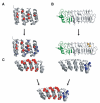NextGen protein design
- PMID: 24059497
- PMCID: PMC4051282
- DOI: 10.1042/BST20130112
NextGen protein design
Abstract
Protein engineering is at an exciting stage because designed protein-protein interactions are being used in many applications. For instance, three designed proteins are now in clinical trials. Although there have been many successes over the last decade, protein engineering still faces numerous challenges. Often, designs do not work as anticipated and they still require substantial redesign. The present review focuses on the successes, the challenges and the limitations of rational protein design today.
Figures


Similar articles
-
Dynamics, a Powerful Component of Current and Future in Silico Approaches for Protein Design and Engineering.Int J Mol Sci. 2020 Apr 14;21(8):2713. doi: 10.3390/ijms21082713. Int J Mol Sci. 2020. PMID: 32295283 Free PMC article. Review.
-
Computational protein design-the next generation tool to expand synthetic biology applications.Curr Opin Biotechnol. 2018 Aug;52:145-152. doi: 10.1016/j.copbio.2018.04.001. Epub 2018 May 2. Curr Opin Biotechnol. 2018. PMID: 29729544 Review.
-
Computational protein design with backbone plasticity.Biochem Soc Trans. 2016 Oct 15;44(5):1523-1529. doi: 10.1042/BST20160155. Epub 2016 Oct 19. Biochem Soc Trans. 2016. PMID: 27911735 Free PMC article. Review.
-
Progress in computational protein design.Curr Opin Biotechnol. 2007 Aug;18(4):305-11. doi: 10.1016/j.copbio.2007.04.009. Epub 2007 Jul 20. Curr Opin Biotechnol. 2007. PMID: 17644370 Free PMC article. Review.
-
Advances in computational protein design.Curr Opin Struct Biol. 2004 Aug;14(4):487-94. doi: 10.1016/j.sbi.2004.06.002. Curr Opin Struct Biol. 2004. PMID: 15313244 Review.
Cited by
-
CODV-Ig, a universal bispecific tetravalent and multifunctional immunoglobulin format for medical applications.MAbs. 2016 Jul;8(5):867-78. doi: 10.1080/19420862.2016.1162932. Epub 2016 Mar 16. MAbs. 2016. PMID: 26984268 Free PMC article.
-
Purification and assembly of thermostable Cy5 labeled γ-PNAs into a 3D DNA nanocage.Artif DNA PNA XNA. 2014 Dec 15;5(3):e992181. doi: 10.4161/1949095X.2014.992181. Artif DNA PNA XNA. 2014. PMID: 27430048 Free PMC article.
-
A designed repeat protein as an affinity capture reagent.Biochem Soc Trans. 2015 Oct;43(5):874-80. doi: 10.1042/BST20150091. Biochem Soc Trans. 2015. PMID: 26517897 Free PMC article. Review.
-
PyFolding: Open-Source Graphing, Simulation, and Analysis of the Biophysical Properties of Proteins.Biophys J. 2018 Feb 6;114(3):516-521. doi: 10.1016/j.bpj.2017.11.3779. Biophys J. 2018. PMID: 29414697 Free PMC article.
-
Functionalization of a symmetric protein scaffold: Redundant folding nuclei and alternative oligomeric folding pathways.Protein Sci. 2022 May;31(5):e4301. doi: 10.1002/pro.4301. Protein Sci. 2022. PMID: 35481645 Free PMC article.
References
-
- Koide A, Bailey CW, Huang X, Koide S. The fibronectin type III domain as a scaffold for novel binding proteins. J. Mol. Biol. 1998;284:1141–1151. - PubMed
-
- Nord K, Gunneriusson E, Ringdahl J, Ståhl S, Uhlén M, Nygren P. Binding proteins selected from combinatorial libraries of an α-helical bacterial receptor domain. Nat. Biotechnol. 1997;15:772–777. - PubMed
-
- Reina J, Lacroix E, Hobson SD, Fernandez-Ballester G, Rybin V, Schwab MS, Serrano L, Gonzalez C. Computer-aided design of a PDZ domain to recognize new target sequences. Nat. Struct. Biol. 2002;9:621–627. - PubMed
-
- Hiipakka M, Poikonen K, Saksela K. SH3 domains with high affinity and engineered ligand specificities targeted to HIV-1 Nef. J. Mol. Biol. 1999;293:1097–1106. - PubMed
Publication types
MeSH terms
Substances
Grants and funding
LinkOut - more resources
Full Text Sources
Other Literature Sources

